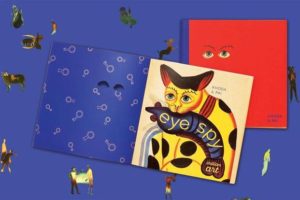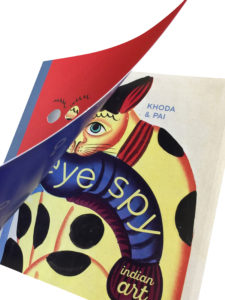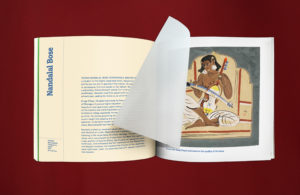Eye Spy Indian Art: A peephole view
 ( This article was published in Mint on 11 February 2017. Ritu Khoda and Vanita Pai’s book, which recently won the Hindu-Goodword children’s book award, takes its young readers on a ride through the history of modern Indian art. The book is published by Takshila Publication and is available on Amazon. )
( This article was published in Mint on 11 February 2017. Ritu Khoda and Vanita Pai’s book, which recently won the Hindu-Goodword children’s book award, takes its young readers on a ride through the history of modern Indian art. The book is published by Takshila Publication and is available on Amazon. )
In 2015, at a workshop organized by art educators Ritu Khoda and Vanita Pai during DAG Modern’s exhibition, A Visual History Of Indian Modern Art, in Mumbai, children played an “eye spy” game. They were each given a cut-out of an eye that was part of a painting in the gallery; and they had to find the match. When they found the right painting, they had to write the name of the artist, the year of conception, the name of the painting and the school of art it belonged to.
The success of this experiment led Khoda and Pai to attempt the game in book form. Eye Spy Indian Art, a tactile book with a number of flaps, foldouts, stickers and die-cuts, has just won the Hindu Young World—Goodbooks Best Author award at The Hindu Lit for Life.
The excitement of the game, say the authors, really begins with the book cover. “A cover without a title? Why not? We added an element of intrigue by showing a pair of blue eyes peering through die-cut sockets. At first glance, the eyes look human, but on opening the cover, one is presented with a Kalighat painting of a cat,” says Pai.
Eye Spy contextualizes company painting, moving to Raja Ravi Varma’s academic realism and stopping at the Baroda school. It offers a comprehensive understanding of the emergence of art movements in India; along with the independence movement, artists were consciously trying to carve their own identity through a distinct art language.
It was their passion for art education that brought the authors, who are actually management and communication professionals, together. “It became crucial to generate awareness about what art learning can offer in terms of transformative thinking,” says Khoda. She had already set up the Art1st Foundation, which works in the field of art education, when she met Pai. “Ritu had written school books but she wanted to create literature on Indian art which could be taken to a much larger audience. And that’s where we connected,” says Pai. “We were concerned that children do not know the fundamentals of art, our rich art history, or about our Indian artists and their life journey. We decided to make books that would instil a sense of pride and heighten awareness about our rich visual art heritage.”

The Hindi version of ‘Raza’s Bindu’.
Their first book together was Raza’s Bindu, published by Scholastic India. They linked it with the basic concepts of art—dots and lines— to engage children, realizing that Raza’s vibrant art appealed greatly to children: When you bring pen to paper, what emerges first is a bindu, they say. This book has now been translated and published in Hindi by Eklavya.
The response to both books seems to have been tremendous; several schools across India have included them in the curriculum. Publishers such as Tulika and Tara Books have earlier published wonderful titles introducing art to children, but Eye Spy is probably the first innovative experiment in print introducing children to a timeline in modern Indian art.
11 February 2017


